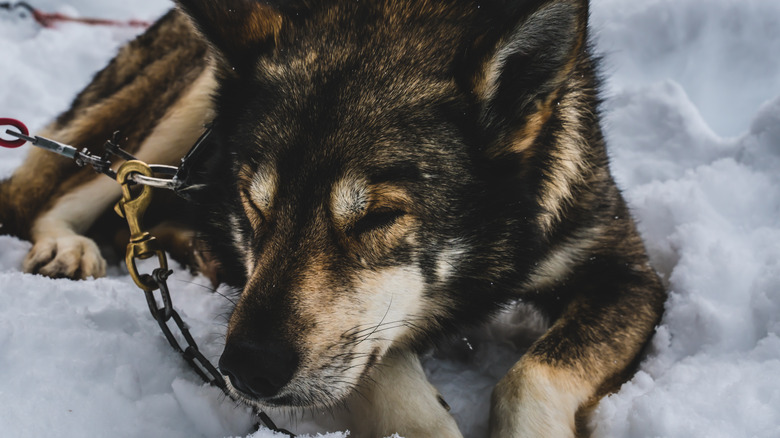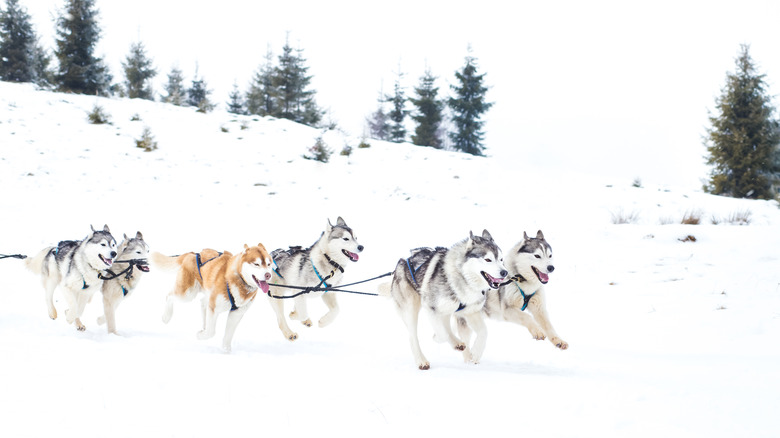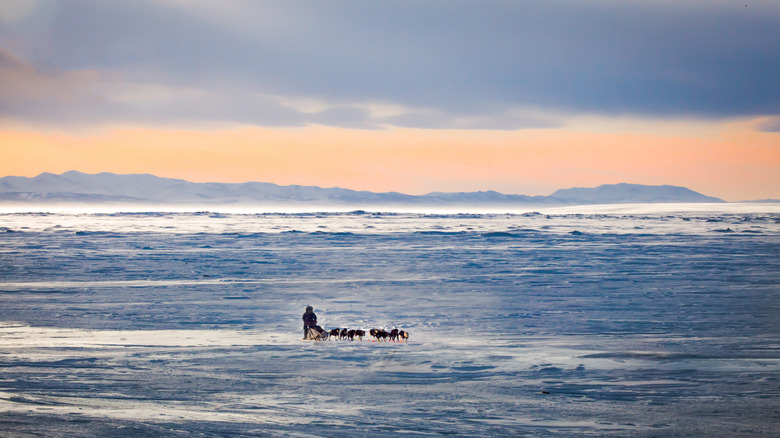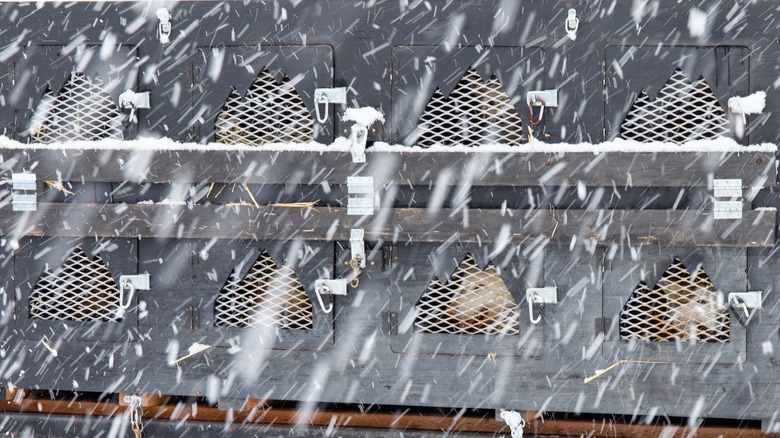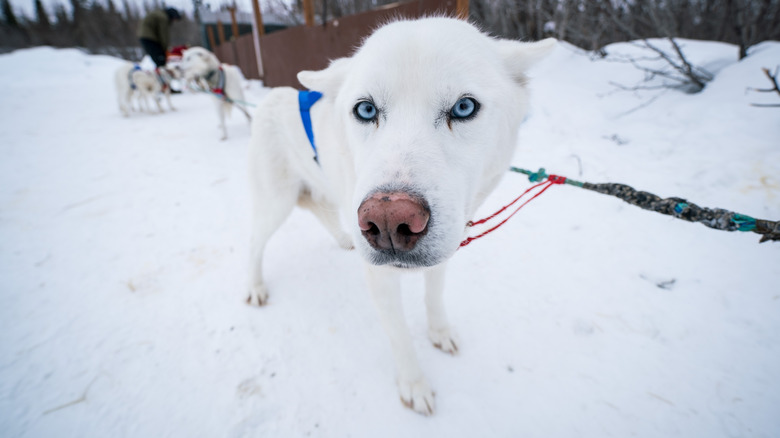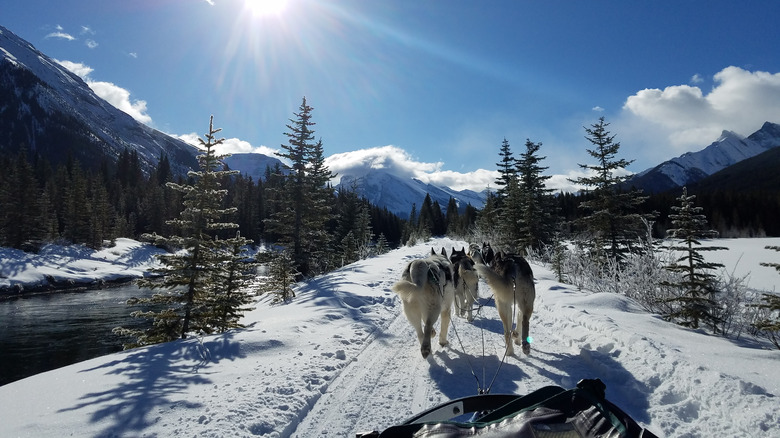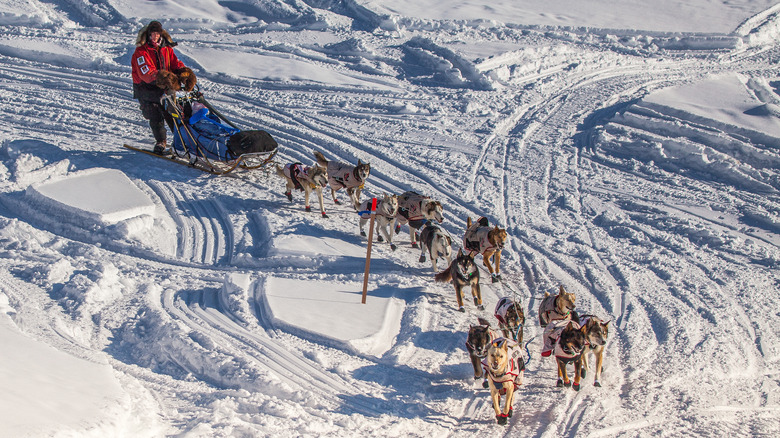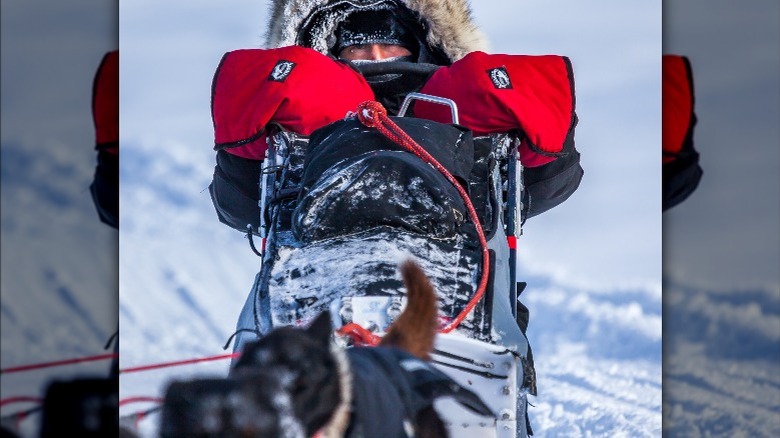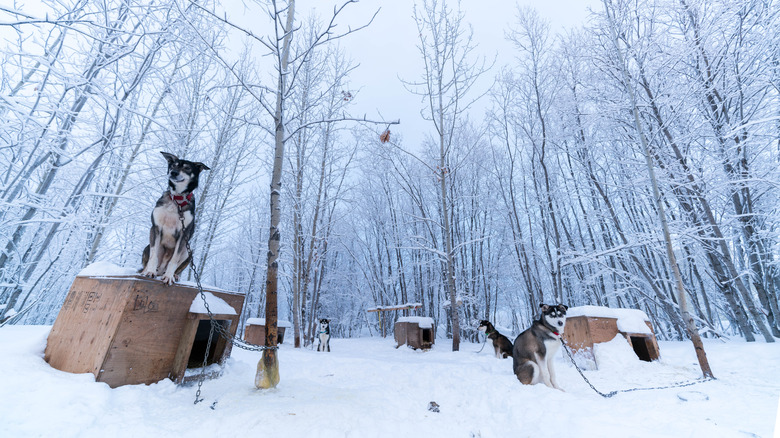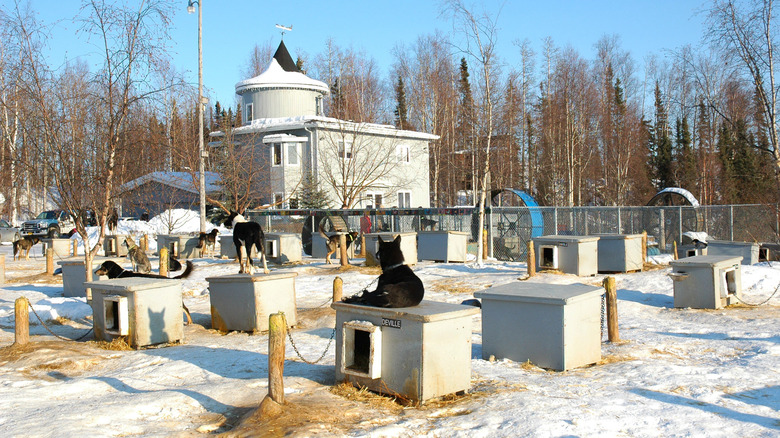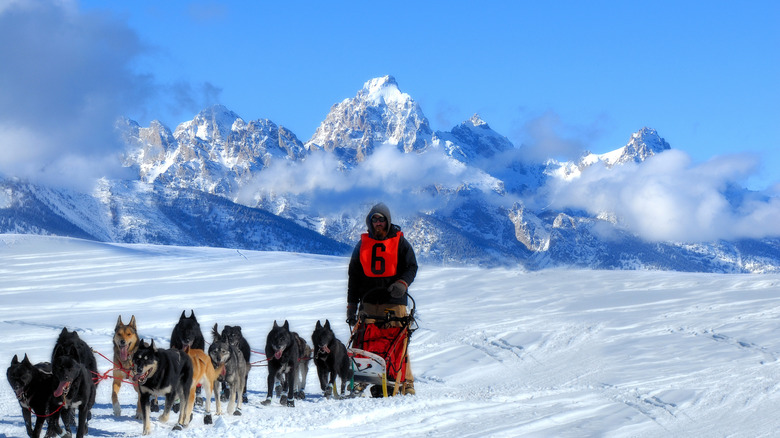The Dark Truth About The Iditarod
Alaska's Iditarod race has long captured the national imagination. Attesting to its popularity are the high number of books written about the event, including Gary Paulsen's "Woodsong" and "Winterdance: The Fine Madness of Running the Iditarod" (via GoodReads). There's also James A. Michener's stunning work "Alaska" which delves into the iconic race, calling it, without exaggeration, "the world's most demanding organized competition."
While Jack London never lived to see the birth of the sporting event, his great literary classics like "White Fang" and "The Call of the Wild" paved the way for the romanticism of this race. While there's something tantalizing and inexpressible about facing off against the worst nature has to offer and winning, it takes a toll on sledders and dogs alike. In recent years, groups such as People for the Ethical Treatment of Animals (PETA) and the Sled Dog Action Coalition have started asking whether this toll is ultimately too high.
Romanticizing aside, the race demands everything mushers and their dogs have to give and then some. It's not unlike running a marathon, another extreme sport that comes with inherent risks. But as The Dogington Post notes, there's one big difference. The dogs born and bred for the Iditarod don't have a choice when it comes to competing. Here's what you need to know about the dark side of the Iditarod.
The race covers more than 1,000 miles
Every year, Alaska's backcountry holds one of the most iconic races in American history, the Iditarod. Known as "The Last Great Race," the event represents the ultimate competition of human versus nature with a hefty dose of canine power (via The Dogington Post). Each sled dog team starts out with 16 furry companions, and they complete the race with at least six four-legged friends intact, as reported by National Geographic.
Those are some ominous numbers when you consider the loss of each dog places a tremendous burden on remaining pack members. The grueling race covers anywhere between 1,049 and 1,150 miles, cutting through exceedingly desolate terrain between Anchorage and Nome, Alaska, per PETA and National Geographic. (The route varies slightly from year to year.) For comparison, that's equivalent to the distance between New York City, New York, and Sioux Falls, South Dakota, only without the benefit of roads or infrastructure (via "Alaska"). Not only does this point to just how massive the 49th state is, but it begins to illustrate the demanding nature of the Iditarod.
It typically takes between nine and 12 days to complete, with dog sled teams traveling, on average, 100 miles per day. The race covers challenging terrain including frozen waterways, slick paths, challenging climbs, and plenty of barren tundra. Really, the term "Iditarod" says it all. It comes from an Athabaskan Indian word that translates as "a distant place" and is said "hi-dit-a-rod."
Dogs die during the race
Dog deaths at the Iditarod happen, some preventable and others not. According to PETA, Nash died in 2016 after being hit by a snowmobile, and a car hit Stuart the year before. Dogs also die on the trail, including Stiffy and Wyatt in 2015. Supporters of the event argue that the sheer number of dogs participating in the race — 1,100 — makes fatalities inevitable (via the Sled Dog Action Coalition), especially when coupled with the frigid harshness of Alaska's terrain and climate.
Veterinarians, a constant presence at the event, echo these sentiments, saying fatalities are inevitable due to the high number of dogs present. But some say canine deaths also underscore the Iditarod's dark side. As Mike Doogan stated in the Anchorage Daily News in 1994, "Competitive dog mushing is built on dead dogs, from the time slow-looking puppies are culled to the moment some overbred, undersized racing hound expires of overexertion" (quoted by the Sled Dog Action Coalition). The question remains, is this statement true nearly 30 years later?
In 2016, one sled dog suffocated during a snowstorm, shedding light on the dangers of conditions for dogs retired from the race. After Paige Drobny of Fairbanks, Alaska, determined a 4-year-old sled dog named Dorado didn't look well, she left him with workers in Unalakleet for shuttling out via airplane. But a snowstorm grounded the planes. After five and a half hours buried in snow, Dorado perished, per the Anchorage Daily News.
A doping scandal rocked the Iditarod
If the allegations of animal abuse against the Iditarod weren't enough, another layer of scandal enveloped the competition in 2017, per the Weather Channel. That's when a doping scandal hit the airwaves involving one of the oldest and most successful musher families in the race's history, the Seaveys.
Dallas Seavey, an Iditarod champion four times over and third-generation musher faced disgrace after four of his sled dogs tested positive for the illegal opioid tramadol. Following the test results, Seavey vehemently denied the charges, pointing out the many ways the dogs could have been drugged by others with tainted food or treats. He also pointed out that it wasn't in his best interest to give the dogs tramadol, which would have rendered them slow and drowsy.
As for culprits to a potential animal drugging, Seavey had a list of suspects. These included competitors and even members of animal activist groups that oppose the race and want to put it to an end. He also spoke out against the Iditarod's officials for not providing better security when it comes to the food and water left at drop-off points in the weeks before the race takes place. In an official statement, he claimed, "All I can say 100 percent is I did not give this to my dogs. So now we have to look at the other possibilities" (via the Weather Channel).
Nearly 150 dogs dead in the Iditarod
Since its start in 1973, the Iditarod has resulted in the deaths of 142 dogs. The Dogington Post notes that this is relatively low when compared to human activities such as contact and racing sports. What's more, many of the 142 deaths attributed to the Iditarod aren't a direct result of the race. According to Rolling Stone, some have resulted from transporting so many animals to one location at the same time. For example, one canine died from overheating on the plane flight to Alaska.
PETA has detailed other sled dog deaths in recent years, and many have involved unforeseen accidents like getting run over by a snowmobile, hit by a car, or even attacked by a moose (via Alaska Public Media). Some people claim more egregious offenses take place away from the public eye. In the wake of the hubbub over Dallas Seavey's allegedly doped dogs, many accusations within the dog sledding world emerged. The Weather Channel reports these included troubling charges by Zoya DeNure, a veteran sled dog competitor.
When interviewing people who used to work at the Seavey family kennels, former employees discussed culling dogs unfavorable for racing. DeNure claims this is a common tactic for dealing with mediocre dogs at other kennels, too. But these charges, relayed through a secondary source, amount to hearsay and would not be admissible in court. Nevertheless, they've left a bad taste in some people's mouths. In response, Dallas Seavey's wife, Jennifer Seavey has vigorously denied such charges.
Rule 42 governs canine deaths
The Iditarod includes a comprehensive list of rules, meant to ensure the safety of the humans and animals participating in the event. But as PETA points out, canine injuries and deaths prove so common that Rule 42 exists. This legislation outlines what the competition considers to be unpreventable canine deaths.
Rule 42 states, "The Iditarod holds firmly that no dog should suffer harm or death in connection to the race. However, it is understood that, in rare circumstances, dog harm or death can occur through no fault of the musher." In the case of a canine death, the musher must fill out a report and turn it in with the remains of the dog for examination. The rule also prescribes that a veterinarian who's board certified must perform a necropsy on the animal.
According to Rule 42, all dog deaths should be investigated within 30 days of the race by the Dog Care Panel. Dog deaths ruled preventable result in the musher withdrawing from or being scratched from the competition. Certain rulings for dog deaths mean disqualification of the musher, including inhumane treatment, neglect, and abusive treatment. But groups like PETA argue that the very presence of Rule 42 renders Iditarod-related canine deaths commonplace.
Temperatures rarely rise above zero
Another essential rule of the Iditarod is Rule 43, which deals with the arctic-travel readiness of the dogs involved in the race. This rule makes it clear that only dogs considered by officials to be equipped for dealing with the frigidity of early spring in Alaska can compete. Determining the suitability of each musher's canines are race officials.
There's an obvious reason for this rule. The Iditarod cuts through some of Alaska's most inhospitable terrain with correspondingly harsh temperatures, as reported by The Dogington Post. Temperatures of zero degrees Fahrenheit are considered mild with the weather often falling 20 degrees Fahrenheit below zero at night. What's more, during storms or especially inclement weather, it's not surprising to face temperatures of 40 to 50 below zero.
That said, climate change may be doing a number on the race, according to Reuters. In recent years, record-breaking warm temperatures have dogged the event. While this might sound like an improvement for the animals, it can lead to other dangerous issues like the trail covered in sheets of treacherous ice rather than layers of soft, powdery snow. In 2020, flooding plagued the trail, leading to the need to rescue mushers and dogs alike just 25 miles from the finish line in Nome. Rob Urbach, CEO of the Iditarod race, observes, "Alaska is a bit of a poster child for global warming" (via Reuters). Rising temperatures stand to drastically change the race.
Allegations of animal abuse abound
In recent years, PETA and groups like the Sled Dog Action Coalition have made numerous allegations about animal cruelty in conjunction with the race. And as Zoya DeNure's claims demonstrate (as reported by the Weather Channel), it's hard to know what goes on in isolated dog sled kennels in Alaska and the contiguous United States before race day.
But arguments could also be made that the race itself is cruel. For example, the official rules of the Iditarod only stipulate that dogs receive 40 hours of rest over the course of nearly two weeks, as reported by PETA. These guidelines are supported by Alaska's lack of legislation when it comes to preventing animals from getting overworked or overdriven.
What's more, the official rules include a non-disclosure agreement (NDA) that covers the race and continues for 45 days after the event. The NDA portion of the Iditarod's rules restricts mushers from "mak[ing] public statements or engag[ing] in any public conduct injurious to and in reckless disregard of the best interests of the Race. This includes public statements or acts which are disparaging to any of the sponsors of that year's Race" (as quoted by PETA). Such prohibitive language has rendered speaking out against the race and its participants potentially lethal to a musher's career. Yet, the numbers speak for themselves. According to the Sled Dog Action Coalition, between 2002 and 2015, only 51% of all dogs who start the Iditarod finish.
The Iditarod leads to long-term injuries
Like cross-country skiers and others involved in cold-weather sports, the dogs that race in the Iditarod face lung disease related to cold air intake. Approximately 80% of canine participants end up with persistent lung damage, as reported by the American Journal of Respiratory and Critical Care Medicine. Interestingly, human athletes who participate in cold weather sports such as cross-country skiing and ice skating also report increased incidence of lower airway disease related to the constant intake of air that's not properly heated before entering the body. Researchers in this study even hypothesize that studying racing sled dogs could provide a handy correlative for studying lung hyper-reactivity and inflammation disease in humans.
Sled dogs who race also show a high likelihood of developing digestive problems, according to the Journal of Veterinarian Medicine. Roughly 61% of sled dogs deal with an increased rate of stomach ulcers and erosion. Again, there are similarities found in human beings. The study explains, "Gastric ulcers and gastrointestinal bleeding associated with severe physical exertion in human athletes have been reported several times since the early 1980s."
But the very nature of dog sledding precludes the animals from opting out of an event, and it could lead to them overexerting themselves once injured, pushed along by the musher and other dogs on the team. Whatever the case, many animals remain permanently scarred by their experiences in the Iditarod.
Few of the thousands of dogs bred for the race make the cut
Iditarod championship breeding programs involve thousands of dogs, with only a select few chosen for the big event, per the Sled Dog Action Coalition. These dogs are bred for speed and endurance. Yet, those that don't end up on the starting lines face a lifetime chained up outdoors, as reported by PETA. Ashley Keith, a volunteer with Sled Dog Action Coalition and former Iditarod dog handler, has seen the conditions firsthand.
Keith refers to leaving dogs tethered indefinitely as one of many inhumane practices considered standard. Tethering is exacerbated by the fact the dogs are never taken off these tethers. Many end up stuck outside in extreme weather conditions with little in the way of shelter. Some kennels in Alaska allegedly don't even provide their animals with proper bedding, despite the harsh cold of winter temperatures.
Even more sickening, Keith details the experiences she had at one of the industry-leading kennels in Alaska. At this point, Keith had already spent 19 years in the sport, working at kennels in the lower 48 states. She even had dreams of someday competing in the Iditarod. But the practices at this kennel made her leave the industry. One case still haunts her. She noticed a male husky with intense abdominal pain who appeared dehydrated and refused to eat. She reported this for several days to kennel authorities who ignored the problem. Finally, she alleges they shot the sick dog.
Treatment at dog kennels can vary drastically
Recent controversy surrounding the Iditarod has led to allegations on both sides of the table. But when it comes to treatment at dog kennels, this varies widely based on the facility. You'll find cases where dogs receive excellent care and others where empathy and careful maintenance are lacking. Where mushing has become big business, dogs may suffer (via PETA).
As Ashley Keith points out, laws on the books already exist to protect animals from cruelty, but they don't always get enforced. She argues, "Typical sled dog houses do not meet minimum requirements for dogs kept outdoors per animal cruelty laws," according to the Sled Dog Action Coalition. Where laws aren't strictly enforced, there's always the potential for animals to suffer.
Nevertheless, another side to the story exists that can be easy to overlook, as reported by The Dogington Post. Dagney McKinley of Wild Hearts Dog Sledding the Rockies has worked with mushers for years, including Kris Hoffman. McKinley explains that Hoffman has raced the Iditarod, and there's a running joke at his kennel that he has 100 children because of the way he spoils his dogs. Unlike domesticated canines forced into a sedentary existence, McKinley notes that sled dogs may live up to 20 years because of their top physical conditioning. As she argues, "These dogs live to run. Many people think sled dogs look too thin, but they forget, these dogs exercise every day and are in top athletic shape."
It pushes sled teams to the brink
The Iditarod is an extreme sport, which means sled teams get pushed to the very brink, as reported by Rolling Stone. The dogs have been bred for performance and endurance rather than appearance or other factors. But the event is still incredibly intense and puts both dogs and their owners at risk.
While no humans have been killed in the Iditarod, there have been close calls. In some cases, sled dogs have stepped in to save mushers. In an interview with the Weather Channel, Jason Campeau, a Canadian musher recalled. "[One] dog has saved my life three times in the past year." These near misses, even for the human members of a sled team, point to just how dangerous dog sledding and the Alaskan race are. Surviving and overcoming what many might consider impossible natural conditions breeds a deep sense of respect among many mushers for their dogs, according to The Dogington Post.
With all the negative press in recent years, Iditarod mushers face greater scrutiny than ever before. They also expect more from the animals they breed and raise than your average dog owner. But as Rolling Stone points out, not expecting enough from dogs comes with significant health risks from a sedentary lifestyle. What's more, NBC News points out that sled dogs boast chart-topping aerobic capacities, ability to adapt to exercise, and efficiency in using food for fuel. The only animals that beat them in these areas are their ancestors, wolves.
